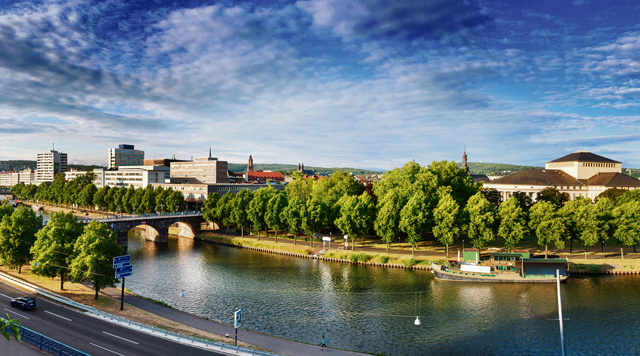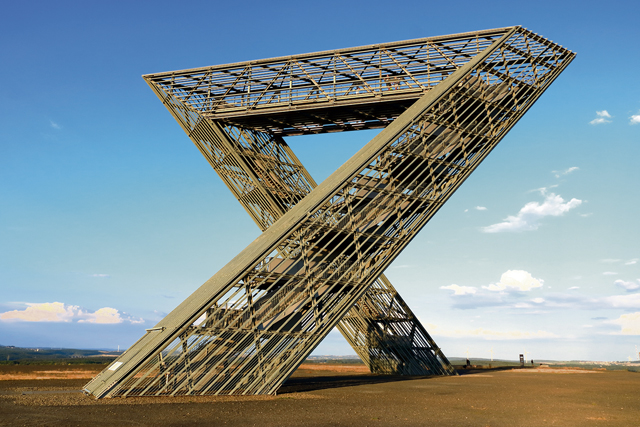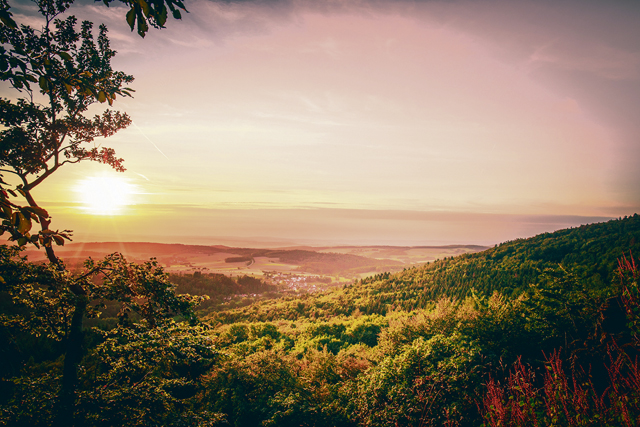
Many members of the Kaiserslautern Military Community have found temporary or even permanent homes in one of the many villages and towns surrounding Kaiserslautern in the heart of Rheinland-Pfalz. You may already be familiar with your immediate vicinity, but there is much more to explore and experience at your “home away from home.”
State of the Art is a series introducing Germany as a whole, but also highlighting an individual state or “Bundesland” every month.
The Federal Republic of Germany (West Germany) was established May 23, 1949, with Bonn being the provisional capital. The states of Rheinland-Pfalz, Nordrhein-Westfalen, Hessen, Baden-Württemberg, Bayern, Niedersachsen, Schleswig-Holstein, the City States of Bremen, Hamburg as well as West Berlin, in its geographically isolated location, belonged to the federal republic. The small state of Saarland remained under French government until 1957.
The foundation of the German Democratic Republic (East Germany) followed on Oct. 7, 1949, including the states of Brandenburg, Thüringen, Sachsen-Anhalt, Sach-sen, Mecklenburg-Vorpommern and East Berlin as its capital.
After the fall of the Berlin Wall in 1989, both countries were re-united in 1990 to make up the current nation with 16 individual “Bundesländer” and Berlin again became the capital.
Germany is a democratic, federal parliamentary republic, where federal legislative power is vested in the Bundestag (parliament in Berlin) and the Bundesrat (representative body of the states in Berlin). The current government is comprised of a coalition of three parties, Olaf Scholz of the SPD as the majority party is the elected Federal Chancellor.
Based on the party colors, it is often referred to as “Ampel-Koaltion” (traffic light coalition). The SPD (Social Democratic Party – is represented in red), the FDP (Free Democratic Party – yellow) and the Grüne/Bündnis 90 (Greens/Alliance 90) – green).
Each month we will feature a different state and provide facts about its history, heritage, industry and commerce, places of interest as well as experiences it offers. This month will feature both the states of Saarland and Hessen.
Saarland — a small gem
Let us begin with our closest neighbor, Saarland, located just 20 km southwest of Ramstein Air Base. It is the smallest federal state “Bundesland” in Germany and has a unique history.

Saarland is 2.569 km² (992 sqm) in size and has a population of 990,000. It borders France to the south and Luxembourg to the west.
Based on wars and conflicts throughout centuries, Saarland belonged to France, then Germany and again France, and the citizens developed strong Francophile ties. Up until around the year 2000, children learned French as their second language in school, rather than English.
After World War II the region was occupied by French forces and in the Paris Agreement of Oct. 23, 1954, France offered to establish an independent “Saarland.” In a public referendum held in October 1955 this plan was rejected by 67 percent and this was interpreted as support for the Saar to join the Federal Republic of Germany instead. The Saar then joined West Germany Jan. 1, 1957, but the Franc remained legal tender until July 1959. After 13 years of separation, the “Kleine Wiedervereinigung” (little reunification) was completed.
Mining through the Ages
The state is mainly characterized by coal mining and heavy steel industry. Mining in the Saar region dates back to Celtic times but was first officially documented in 1429. Mining mainly concentrated on hard (black) coal and industrialization beginning in the 1850s brought with it a high demand for coal to produce steel and irons products, such as steam engines. There was a total of twelve mines in the region and, at peak times, up to 60,000 people made a living as miners underground.
Mining activities near Schwalbach led to multiple heavy eruptions in 2007 and 2008 and an earthquake near Saarwellingen in 2008 accounted for the heaviest quake caused by mining ever recorded. In addition, various sinkholes were detected in the region. As a consequence, the government determined that all mines would cease operations by mid-2012.
However, Saarland continues to be a leading producer and exporter of heavy steel and iron parts, also for the automobile industry in the USA. A large automobile manufacturer is located in Dillingen, near Saarlouis. While mining has been terminated, coal is still required and long barges on the Saar River carry the “black gold,” imported from as far as South America to the various steel works.
Saarbrücken and its historical treasures
Saarbrücken is the capital and is located about 56 km southwest of Ramstein along the banks of the Saar River. It is also the largest city with a population of 180,000 and is just 5 km north of France. The Landtag (State Parliament) is located there with Anke Rehlinger being the head of the SPD (Social Democratic Party) as Minister President and has been in office since April 2022.
The city has a lot to offer when it comes to culture and sightseeing. The Palace, a Baroque structure, and its gardens is a UNECO Cultural Heritage Site. St. Johanner Markt in the heart of the city offers cafés and restaurants, evening entertainment as well as a shopping district. Ludwigskirche (church) and its square are well worth a visit. You can stroll, relax or picknick at the Deutsch-Französischer Garten (German-French Garden) or try your luck at Casino Saarbrücken. A boat ride on the Saar River or a leisure walk along the banks can be a delight. The bridge “Alte Brücke” was built in 1546 and is one of the oldest structures in the city.
The Völklinger Hütte, formerly the largest ironworks, has been developed into a modern museum that not only displays mining equipment and the lives and times of miners. It is also a UNESCO Cultural Heritage Site with varying displays throughout the year, such as an Ancient Egyptian Exhibition, and offers interactive activities for young and older visitors as well as spectacular events. https://voelklinger-huette.org/en/
Saarlouis and the Sun King
Saarland’s third largest city Saarlouis with a population of 35,000 was founded by French King Louis XIV, known as the “sun king,” in 1680. Remains of the French and later Prussian times can be seen almost anywhere in the city. A part of a fortress welcomes guests when driving into town and the lively market square, a former parade ground, with its old town hall, church and main shopping area is also venue for a number of fests and activities throughout the year. Enjoying a café au lait or a tarte flambée in the neighboring and very picturesque historic district will “catapult” you right into France.
American traces in Homburg
Homburg is the second largest city in Saarland with 41,000 inhabitants and it is just a “skip and a hop” away from the Kaiserslautern Military Community. Did you know that Homburg is not only famous for good “Karlsberg” beer and a nice town but also full of American traces? Follow them and learn more about unsung heroes and poets, pioneers and influential emigrants–and why George Washington’s Aide-de-Camp was the first American tourist who was known by name.
Begin your tour on “Liberty Road” and opposite the former headquarters of the U.S. Army in 1945 when the Thunderbird Division occupied the city and the front page of the New York Times Magazine proclaimed, “We take over,” showing GIs in front of Homburg’s old town hall. Two centuries earlier soldiers from Homburg overwhelmed Cornwall’s troops at Yorktown and contributed to American liberty. Later, emigrants from Homburg were known as pioneers, founded Stockton (CA), influenced America’s political life, or fought in the Civil War on both sides. Strolling through Homburg’s Old Town you can also get an impression of the first houses in New York when it was still named Nieuw Amsterdam.
Furthermore, today’s Homburg is interesting with cozy lanes, inviting pubs and restaurants — and many shops accept VAT forms thanks to a local initiative to pay tribute to long and manifold German-American relations and Saarpfalz district’s partnership with Henrico County (VA). Other unique attractions are the “Schlossberghoehlen,” which are Europe’s biggest sandstone caves, and the Roman Museum in Schwarzenacker, which displays remnants of early times. Homburg is also home to the largest hospital complex in the region, the Universitätskliniken along with a university, which specializes in medicine. Crown your visit with a view from scenic hill “Schlossberg,” Homburg’s beautiful castle. – Tours are offered upon request by https://www.daf-saarpfalz.de/ or visit www.homburg.de for general information.
The Saarland may be Germany’s smallest state, but it is a real gem and has much more to discover.
Äppelwoi in Hessen
Another direct neighbor to Rheinland-Pfalz is the state of Hessen (HE) located northeast and almost exactly in the middle of Germany. It is also well known for its “Äppelwoi” (apple wine). The state offers a huge scenic diversity with medieval towns, rolling hills and is also renowned as Europe’s financial metropolis in Frankfurt. The state has a size of 21,115 km (8,152 sqm) and a population of 6.2 million inhabitants.
Wiesbaden and a Roman Spa
Contrary to common belief, Wiesbaden, rather than Frankfurt/Main, is the capital of the state. Located on the Rhein River across from Mainz in Rheinland-Pfalz, it also has a history of being one of the oldest spa towns in Europe dating back to the Romans. The name translates into “meadow baths,” a reference to its hot geothermic springs and up until 2008, 28 of them were open to the public, with 14 remaining to date.
The Landtag (state parliament) is located in Wiesbaden and Minister President Boris Rhein of the CDU (Christian Democratic Party) has been in office since May 2022.
The city has a population of 290,900 inhabitants, and with an additional 21,000 American citizens affiliated with the U.S. Armed Forces, it is the second largest city after Frankfurt/Main. The city is also famed for its architecture and climate and is sometimes referred to as “Nice of the North.”
Wealth in the form of very luxurious villas, expensive shops in the pedestrian zone in the city center, where any top-notch designer label can be found, is evidence of one of the highest per capita incomes in Germany. It has been rumored that in former times wealthy and upper-class residents lived in Wiesbaden, while their “poor” or working-class counterparts resorted to living in Mainz across the river.
Elvis Presley, a famous American singer, was stationed in nearby Friedberg in the 1950’s and often visited Wiesbaden for musical entertainment.
Taunus mountain range
The Roman Limes (defense wall) was built across the Taunus range, soft rolling hills north of Frankfurt/Main. The highest peak is Grosser Feldberg with an elevation of 878 m (2,880 ft). The complete range is plentiful with forest and a popular spot for hiking, biking and cross-country skiing and sledding in winter. Numerous cozy towns with semi-timbered houses and a Middle Age atmosphere are also situated in the region. Don’t miss out on picturesque Fulda, Marburg, Hanau or Wetzlar and try a sip of “Äppelwoi” in a “Bempel” (a big round wineglass with a green stem) and a typical Bockwurst during your visit.

Frankfurt am Main
The best-known city in Hessen is Frankfurt am Main, situated along the Main River. Its skyscraper skyline houses prestigious banks and other financial corporations is often referred to as “Mainhattan.” The German stock exchange as one of the world’s largest trading centers for securities is located downtown. The Deutsche Börse Visitors Center offers visitors insight into the world of finance in a multimedia display. Visit: https://deutsche-boerse.com/dbg-en/
Frankfurt am Main, not to be confused with Frankfurt an der Oder, located in East Germany, is the largest city in Hessen with a population of 750,000 and has a very diverse cultural society with people of 180 different nations living there. About 1,000,000 commuters travel within or outside of the city every day, making it one of the busiest cities in Germany.
In contrast, there are very peaceful and relaxing spots, such as the promenade along the Main River with cafés and beer gardens, or the Palmengarten, a renowned botanical garden. Historical places such as the medieval Römer or the Nicolai Kirche (church) are well worth a visit and the Frankfurter Zeil is the main shopping district. Sachsenhausen is a popular evening entertainment area with a cozy “small town” atmosphere. The busiest U.S. Consulate in Germany, servicing up to 100,000 American citizens in the country, is also situated in Frankfurt.
As the fourth largest airport in Europe, after Heathrow, Charles de Gaulle and Schiphol, Frankfurt International Airport (IATA code FRA) is a monumental hub for passenger and cargo flights. Originally established in 1912 within a vineyard, it quickly grew to a strategic airfield during World War II and served as a starting point for allied aircraft during the Berlin Airlift. Up until 2005, Rhein-Main Air Base was situated on the south side of the shared runway. Today the airport has three runways and two terminals, while Terminal 3, on the premises of the former base, has been under construction since 2015. On average, the airport handles 208,845 take offs and landings per year, services about 5.2 million passengers per month and 75,000 employees work for or at the airport, making it the largest employer in the region.
Hessen, which calls itself “the land of experiences,” has numerous other treasures to discover and experience.
For more information about the Saarland and Hessen, visit https://www.saarland.de/EN and


